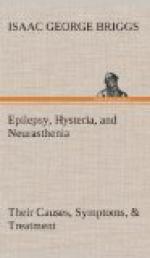Sensationalism is manna to them. They must occupy the limelight. Pains are magnified or manufactured to attract sympathy; they pose as martyrs—refusing food at table, and eating sweets in their room, or stealing down to the larder at night—to the same end. If mild measures fail, then self-mutilation, half-hearted attempts at suicide, and baseless accusations against others are brought into play to focus attention on them.
Minor attacks usually commence with palpitation and a “rising” in the stomach or a lump in the throat, the globus hystericus, which the patient tries to dislodge by repeated swallowing. This is followed by a feeling of suffocation, the patient drags at her neck-band, throws herself into a chair, pants for breath, calls for help, and is generally in a state of great agitation. She may tear her hair, wring her hands, laugh or weep immoderately, and finally swoon. The recovery is gradual, is accompanied by eructations of gas, and a large quantity of pale, limpid, urine may be passed later.
Major attacks have attracted attention through all ages, ancient statues showing the same poses as modern photographs. The beginning stage—which may last a few moments or a few days—is one of mental unrest, the victim being irritable and depressed. In some cases a warning aura then occurs; clutchings at the throat, or the globus hystericus, palpitation, dizziness, sounds in the ears, spots dancing before the eyes, or feelings of intense “tightness” as if the skin is about to tear or the stomach to burst.
The victim throws herself on a chair or couch, from which she slides to the floor, apparently senseless, the head being thrown back, the arms extended, the legs held straight and stiff. The face is that of a dreamer, and the crucifix position is not uncommon. This stage is a gigantic sexual stretch.
Next comes the convulsive stage, but the convulsions are not the true jerky movements of epilepsy, but are bilateral tossing, kicking, and rolling movements, interspersed with various irregular passionate attitudes. There is great alteration but not loss of consciousness. The patient struggles with those about her, bites them, but never her own tongue, shrieks and fights, but never passes urine, throws things about, and arches the back until the body rests on head and feet (opisthotonos). The stretching and convulsive stages alternate, and the attack lasts a long time, being stopped by pain or by the departure of onlookers. During this stage the face may reflect the various emotions passing through the mind—with a fidelity that would rouse the envy of an Irving.
The patient gradually calms down, and a fit of tears or a scream ends the attack, after which the worn-out victim is depressed but not confused, though memory for the events of the attack may only be partial. The patient sometimes passes into the “dream state”, described in Chapter II, for some hours or occasionally for far longer; these are the women described with much gusto in the local Press as being in a trance—“the living dead”.




